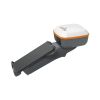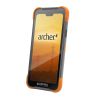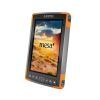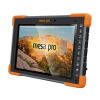Juniper Geode GNSS Receivers
The Juniper Geode is a simple GNSS solution that collects real-time sub-meter data accurately in harsh environments.
Features
- Compatible with iOS, Android, and Windows devices
- Intuitive and easy operation, one-button simplicity
- All day battery life for long work days in the field
- Free ground shipping
- Expedited repair and warranty service
- Lifetime technical support
- More
Overview
The Juniper Geode offers a simple and scalable sub-meter, sub-foot, decimeter, and centimeter GNSS solution at an affordable price. Designed with versatility in mind, the Geode works well with most Apple, Windows, and Android devices. An integrated antenna makes messy cables a thing of the past, yet still has an external antenna port if it’s needed. Take the Geode mounted on a pole, in a pack, or in hand to collect real-time precision GNSS data wherever the job takes you.
Benefits
- Scalable Accuracy - Collect precision multi-frequency, multi-constellation GNSS data at various accuracy levels
- Worldwide Corrections - Multiple correction sources provide precise, real-time data
- Compact Size - Small and lightweight for all-day use
- Open Interface - Works with Juniper Systems' handhelds or your own device
- Simple to Use - Intuitive and easy operation, one-button simplicity
- All-Day Battery Life - Ideal for long work days
- (1) Geode GNSS receiver with integrated antenna and battery
- (1) USB Type-A to USB Type-C cable
- (1) USB Type-C to USB Type-C cable
- (1) 5/8 x 11 pole mount adapter
- (1) USB charger
In The News
Bringing Fish Back: Reviving Britain’s Freshwater Habitats with the Wild Trout Trust
Freshwater covers less than 1% of the Earth’s surface but has an outsized impact on global ecosystems, supporting more than 10% of all known species, reports the World Wildlife Fund . Freshwater environments such as rivers and wetlands provide significant scientific, economic, and cultural value. But pressure from climate change, biodiversity loss, and a lack of prioritization in environmental policies mean freshwater habitats are recognized as one of the most threatened in the world–something scientists have dubbed an “invisible tragedy. ” [caption id="attachment_39210" align="alignnone" width="940"] Remedial works underway to shore up the banks of the River Ecclesbourne.
Read MoreMonitoring and Facilitating Habitat Restoration Efforts in the Great Lakes
While human infrastructure, urbanization, and industrialization have advanced human societies, the natural environment has suffered due to constructed impediments and deteriorating architecture. In order to combat this degradation, habitat restoration programs across the US work to remove impairments and improve damaged waterways. [caption id="attachment_39162" align="aligncenter" width="940"] Barge electrofishing by state and federal employees prior to habitat restoration on Wiscoy Creek which is a tributary to the Genesee River. (Credit Thomas Hoffman)[/caption] Habitat Restoration Efforts in the Great Lakes Tom Hoffman, aquatic habitat restoration biologist in the Lower Great Lakes basin, directs restoration efforts within tributaries to Lake Erie, Lake Ontario, and the St.
Read MoreSustainable Fishing in Alaska: Protecting the Salmon Capital of the World through Research
In the far north, the Alaska Peninsula stretches away from the Last Frontier into the Pacific Ocean. A narrow strip of land dotted with freshwater lakes and intruded upon by ocean inlets–this unique region is intimately connected with the surrounding water. Nestled halfway down the peninsula's southern coast are the small villages of Chignik. The area has historically been home to the Aleut people and has been heavily reliant on fishing for centuries. Home to commercial and subsistence fishing today, Chignik continues to rely upon the salmon returns to the surrounding villages, which are supported by scientists working tirelessly to understand and steward these fish populations.
Read More









































